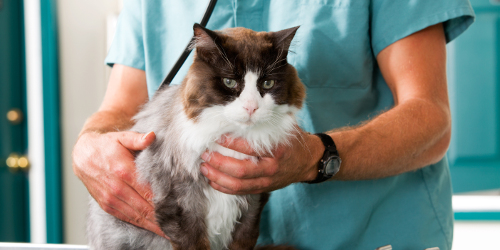
Our animal companions are really good at hiding their health problems from us, especially our sneaky cats. But seeing your veterinarian on a regular basis will help you pick up on these problems, sometimes preventing them from worsening and becoming serious.
Dr. Glynes D. Graham, owner and primary veterinarian of Patterson Dog and Cat Hospital in Detroit said the most common health problems cats face are kidney failure, heart disease (specifically hypertrophic cardiomyopathy) and dental issues such as gingivitis.
"Many times people bring their cats to the vet when it is past the point of being able to help," she said. "We didn't have the opportunity to catch it early and make changes."
For example, heart disease in cats is often accompanied by a heart murmur, which goes undetected by the pet owner.
"The cat doesn't appear to be affected by it so the disease is left untreated, which can cause problems. Cats are highly prone to blood clots if they have heart disease, but if they don't come to the vet, we don't know about it. We are able to diagnose and manage the disease with medication," she said.
But not all cats will take oral medications, whether in pill or liquid form.
"Cats are not always interested in getting with the program. There are a surprising number of transdermal medications that can be wiped on their ears or skin. Some antibiotics can be injected and last seven to 14 days," she said.
As different medication options become available, Dr. Graham encourages cat owners to be up front with their vet.
"If you cannot get your cat to take pills, let your vet know. Some pet owners come back a week later and no medication has been given. Had I known, I might have made a different choice," she said.
While it's not easy to figure out what your cat is thinking or feeling, one thing is true. They do not have nine lives and it's time to bust the cat myths that felines are self-sufficient and aren't exposed to potential health hazards because they never leave the house. Cats need wellness check-ups, vaccines, dental exams and nutritional consultations just as much as their pet owners do, according to the Cat Fancier's Association.
Prevention is preferable to treatment, so Dr. Graham recommends annual physical exams for cats under the age of eight. Cats over the age of eight would benefit from exams every six months.
"Vets vary on recommendations in terms of regular bloodwork," she said, adding that cost should not deter pet owners from at the very least being informed.
"It's up to the pet owner to make the decision about what to do next, but without any information, they won't know what the decision needs to be. This does not mean they have to do what the vet recommends either," she said. "It may be that they are fine and healthy and wonderful. Wouldn't it feel good to know that?"
Sure, but generally speaking, cats hate the vet.
"And owners hate bringing them to the vet, putting them in carriers, listening to them yodel in the car the whole way. It's a pain in the neck," she said. "Unlike dogs who go to the vet and are in the car all the time, cats don't have a lot of experience. They don't like it. The owner doesn't like it. So it doesn't happen."
There are a variety of ways to try and help your cat overcome their fears and reduce their anxiety.
Tips for Taking Your Cat to the Vet
A recent Animal Planet survey revealed that two-thirds of cat parents take their pets to the vet less than once a year, in part because of "feline resistance" to the experience. Here are some suggestions to make the process of taking your cat to the vet a little easier.
Help your cat get comfortable with a travel crate.
Instead of storing your cat's travel crate in a closet, keep it in an area where he or she takes regular cat naps. Let your cat wander in to explore or sniff around the outside every few weeks. Before trips, pad the bottom of the crate with a blanket or t-shirt. The softness of those items, along with your scent might give your cat comfort.
Help your cat calm down.
Try a pheromone spray, such as Feliway, which contains a synthetic form of the scent that cats rub against each other and their loved ones to reinforce social bonds. It can be sprayed on the cat or in the travel crate. Some cat owners rave about Rescue Remedy, which can be added to your cat's water hours before crate time to take the edge off. The vet can prescribe a sedative if necessary. Even the correct dosage of Benadryl can help.
Go for a ride.
Cats like things to be familiar and predictable, and cars are not that. But a mock trip to the vet with your cat can be rewarding. Even if you just drive around the block, the goal of this behavior modification technique is to accustom your cat to being in a carrier and in a car. For most cats, the car ride to the vet is scary and can create a stressful experience. Always reward your cat with their favorite treats so they associate positive experiences with the car drive.
Make sure your cat can see you.
When possible, don't leave your cat alone when its in the crate. Most of the anxiety comes from the unknown of being confined to a small space, but some cats might fear being abandoned especially if they were rescued from a neglectful situation.
Ask for a house call.
Some cats are really distressed when leaving the house and have a complete meltdown at the vet's office. If your cat feels more comfortable at home and nothing else helps the process of going to the vet, then consider finding a vet that comes to you.
For more information about keeping your cat happy and healthy, contact Patterson Dog and Cat Hospital at 3800 Grand River Ave. in Detroit at 313-832-7282 or on their website.











